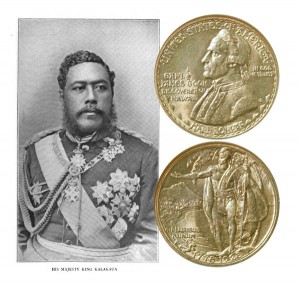Today, the Hawaiian Sesquicentennial Commemorative Silver Half Dollar Coin remembers the first visit of a king to the United States and his first meeting with the president on December 15, 1874, 142 years ago.
First, let’s view a couple of news articles from that time period then a description of the purpose of the visit.
From the Reading Eagle:
=====
Our Royal Visitor
King Kalakaua, of the Sandwich Islands, arrived in Washington on Saturday morning. He was received by Secretaries Fish, Balknap and Robeson, and conveyed under escort of the Marines, to the Arlington House.
The streets along the line of the procession were thronged with people, and flags were displayed from the public offices, hotels and other buildings. On reaching the hotel the King was compelled to take to his bed by a severe cold, from which he still suffers, and which may postpone or change the arrangements for his entertainment this week.
Kalakaua is the first reigning king who has ever visited this country.
The king is a fine looking mulatto, at least six feet high, heavily build and muscular, with a very intelligent and amiable face. He appeared to take matters very quietly and was not at all embarrassed by the presence of the American dignitaries.
He was dressed in a plain business suit of dark color, had no insignia of rank about him, and was totally destitute of jewelry, except a plain gold ring, and could only be singled out from the members of his suite by his great stature and manly bearing.
He and his suite speak English fluently.
=====
From the Boston Evening Transcript:
=====
Official Reception of the Hawaiian King
King Kalakaua was formally presented to the President, this afternoon, at two o’clock. The members of the cabinet, Colonel Grant, General Babcock and Mr. Luckey, private secretary, were assembled in full dress for the purpose of the receiving the king.
On the approach of his majesty’s carriage, the President advanced from the threshold of the Executive Mansion, when the secretary of state and Colonel Grant, the latter personally representing his father, went to the carriage and received the king as he alighted, and accompanying him on either side, crossed the platform to the entrance of the White House, where the President cordially extended his hands and received and welcomed the king, the other members of the cabinet, standing behind the President up to the time that he turned with the king, then entered the room.
The secretary of state then introduced the President to Governor Dominis and Governor Kopena. He then presented the king to the members of the cabinet, General Babcock, Colonel Grant and Mr. Luckey. The President and king shortly seated themselves on a sofa and the other gentlemen moved at pleasure about the room and entered into conversation with one another.
Gradually advancing to where the President and king were seated, a general conversation ensued. After about twenty minutes the king arose and the President accompanied him to the door, the secretary of state and Colonel Grand handed him into his carriage and the ceremony was ended.
=====
In Hawaii’s Story by Hawaii’s Queen, Liliuokalani, published in 1898, she wrote of her brother’s visit to the United States and his meeting with President Grant:
=====
I will now return to the date of the departure of my brother, King Kalakaua, to the United States.
Yielding to the wishes of those residents of his domains who were from American or missionary stock, my brother had organized the negotiation of a treaty of closer alliance or reciprocity with the United States; and even before leaving home he had commissioned Judge Allen and Minister Carter to submit such a treaty to the American government.
To advance the interests of this movement by his personal presence, he accepted passage for himself and his suite on the ship-of-war Benicia, and sailed for San Francisco in the autumn of 1874.
My husband, the late General J. O. Dominis, and United States Minister Henry A. Pierce accompanied him on his travels.
One of the officers of this steamship was Lieutenant Whiting, who received permission to accompany King Kalakaua to Washington. He is now a commander, and has since married Miss Afong, one of a large family of children, all girls, whose mother is one of our people, but whose father was a rich Chinese resident, now returned to his native land.
From the moment of landing my brother made friends, and was treated with the kindest consideration by the American people of all classes.
There was a very strong feeling of friendship between the king and the late General U. S. Grant. It amounted almost to recognized fraternity.
The result of this visit is well known. It secured that for which the planters had gained the endorsement of the king; it resulted in the reciprocity treaty of Jan. 30, 1875.
So this, one of the first official acts of King; but even then there were a few who protested against the treaty, as an act which would put in peril the independence of our nation.
The impressions of the people are sometimes founded upon truth; and events have since proved that such was the case here, — that it was the minority which was right in its judgment of the consequences of the Hawaiian concession of 1875 to the power of the foreigner.
=====
The Hawaiian Sesquicentennial Commemorative Silver Half Dollar Coin shows with an image of King Kalakaua.
